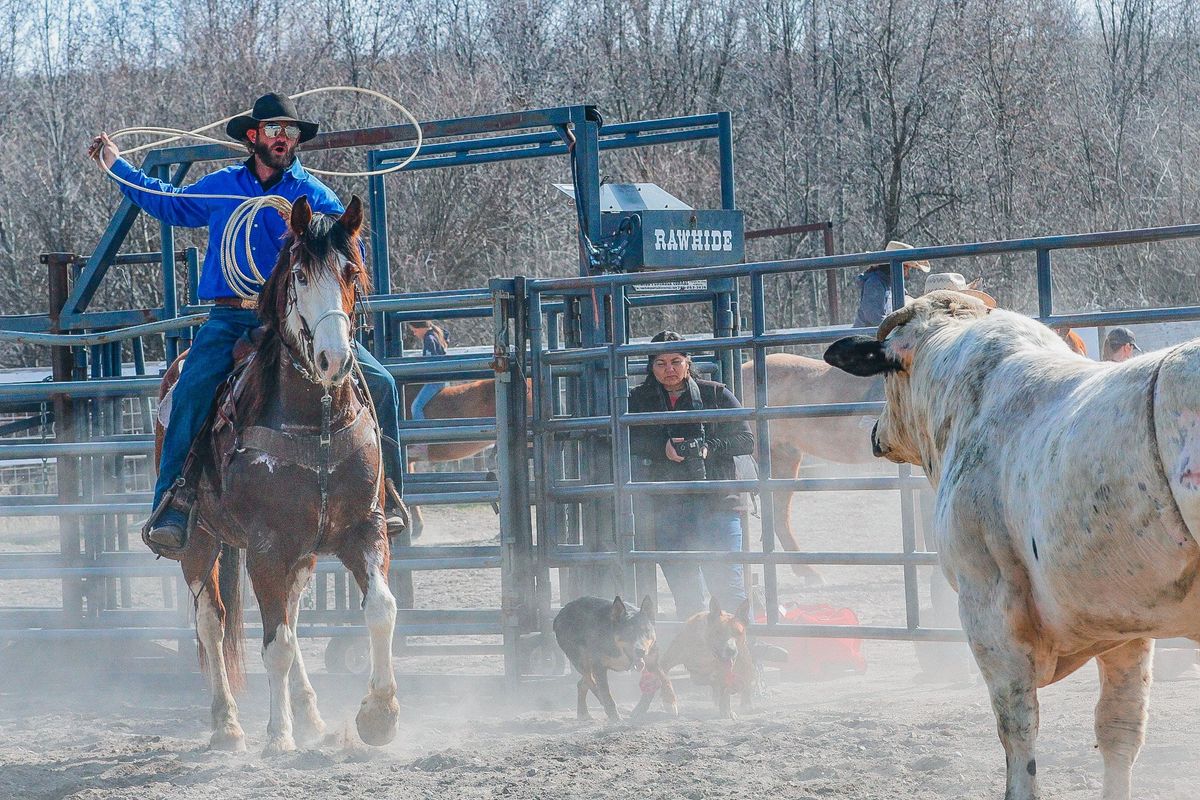Cowboy Life: Ranching and rodeo in Eastern Washington a far cry from the fanciful ‘Yellowstone’

A day in the life of the average Washington citizen may consist of cars, the 9-to-5 and perhaps an episode of the hit Paramount series “Yellowstone.”
Meanwhile, there is another breed found in the rural areas surrounding Spokane that lives a life drastically different than that of the average citizen (not to mention that of Kevin Costner’s “cowboy” role).
Soap Lake’s Caleb McMillan, 25, and 36-year-old Moses Lake-area resident Jacob Stacy are prime examples.
Stacy grew up on his father’s cattle operation near Nespelem. Nowadays, he has his own property near Moses Lake and works directly with Corey & Lange Rodeo Company, one of the Northwest’s premier pro-rodeo stock contractors.
This weekend, he’s working the PRCA Rodeo at the Spokane County Interstate Fair.
But most days, Stacy goes about his routine with a cup of coffee first thing in the morning and choosing about four of his specifically bred and trained cowdogs to work with. Then bales and grain are loaded to feed bucking horses and bulls, along with his own head of cattle and saddle horses, while he checks water and fixes fences along the way.
It’s not unusual for Stacy’s evenings to be rodeo-filled, whether as a competitor or as a pick-up man. Today steer wrestling is his mainstay, but he has competed in saddle bronc riding and team roping as well. As a pickup man, it’s his job to ensure the safety of rodeo cowboys and animals by removing flank straps, roping bulls if necessary and giving bronc riders a place to go after an eight-second ride. As Stacy puts it, “being a pickup man is a lot more work than it looks to be.”
And hand in hand with being a good pickup man comes a good horse, such as one of Stacy’s usual rides. Marlboro is a stocky, paint-patterned horse bred to buck that Stacy would eventually train to be his go-to bull horse. If a bull is acting up and doesn’t feel like exiting the rodeo arena, you can count on the strength of Marlboro and Stacy’s rope to get the job done.
“He’s really, really good at what he does,” Stacy said.
McMillan hails from the McMillan family, who have been stock contractors putting on rodeos for decades, alongside a strong beef cattle business. Thus, he’s ranched and been a part of the rodeo world just about every day of his life.
“It’s just what I’ve done and has become a part of who I am,” McMillan said. “Every day I wake up and it doesn’t matter what we’re doing, it’s all a part of the cowboy lifestyle.”
As the sun rises over the buttes of central Washington, his day usually begins with feeding and checking water that 150 head of bucking horses, 40 saddle horses, 200 of his own beef cattle and about 1,000 feedlot cattle rely on. Fixing fences, sorting stock and loading up trucks to head to a rodeo down the line are also on the usual itinerary.
McMillan doesn’t just handle rodeo stock but also competes as an all-around cowboy, throwing loops in the tie-down and steer roping, tossing steers in the steer wrestling, and gunning for eight during the bull riding.
“Seems like I’m always busy at a rodeo,” McMillan said. “But I do like it that way. Doesn’t give you time to overthink it. You just let your body react and take action.”
Both men are more than willing to live the western lifestyle and the daily challenges that come with it , but why is the way of the cowboy so romanticized? Why do forms of media such as “Yellowstone” that (just a little less than accurately) portray it fascinate so many?
“I honestly think people like the western lifestyle so much because there’s so little, really, left of it,” McMillan said. “The ranches are getting smaller, there’s less of the old-school cowboys around and, honestly, cowboys are the last of a dying breed.”
McMillan and Stacy embody that dying breed, from the early mornings to the late nights. And weekends off? Hardly such a thing. Just this weekend, the McMillans put on the Colfax rodeo while Stacy works Spokane’s own. Yet, they wouldn’t trade it for anything.
So whether it’s authentically living the western life or showing the next generation what the way they’ve grown up is all about – such as Stacy’s eldest children (5-year-old Stevie Lane and 3-year-old Stoney) who are just beginning to help out on the ranch – McMillan and Stacy keep that dying breed alive and well.